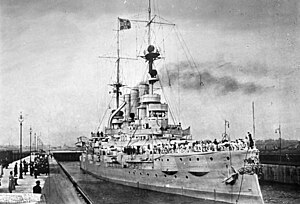SMS Deutschland (1904)

SMS Deutschland in a lock in 1912
|
|
| History | |
|---|---|
|
|
|
| Name: | Deutschland |
| Namesake: | Germany (Deutschland in German) |
| Builder: | Germaniawerft, Kiel |
| Laid down: | 20 June 1903 |
| Launched: | 19 November 1904 |
| Commissioned: | 3 August 1906 |
| Struck: | 25 January 1920 |
| Fate: | Scrapped in 1920 |
| General characteristics | |
| Class and type: | Deutschland-class battleship |
| Displacement: |
|
| Length: | 127.6 m (418 ft 8 in) |
| Beam: | 22.2 m (72 ft 10 in) |
| Draft: | 7.7 m (25 ft 3 in) |
| Propulsion: | 15,781 ihp (11,768 kW), three shafts |
| Speed: | 18 knots (33 km/h; 21 mph) |
| Range: | 4,850 nmi (8,980 km; 5,580 mi) at 10 knots (19 km/h; 12 mph) |
| Complement: | 743 |
| Armament: |
|
| Armor: |
|
SMS Deutschland was the first of five Deutschland-class pre-dreadnought battleships built for the Kaiserliche Marine between 1903 and 1906. She was named after the German name for Germany, and built at the Germaniawerft shipyard in Kiel, where she was launched on 20 November 1904. She was commissioned on 3 August 1906, only a few months before HMS Dreadnought was commissioned, the first of a revolutionary new standard of "all-big-gun" battleships which rendered Deutschland and the rest of her class obsolete.
She served as the flagship of Prince Heinrich until 1913. With the outbreak of World War I in mid-1914, Deutschland and her sisters were tasked with defending the mouth of the Elbe and the German Bight from possible British incursions while the rest of the fleet was being mobilized. Deutschland and the other four ships of her class were then attached to the High Seas Fleet as the II Battle Squadron; the unit participated in most of the large-scale fleet actions in the first two years of war, culminating in the Battle of Jutland on 31 May – 1 June 1916. Late on the first day of the battle, Deutschland and the other pre-dreadnoughts briefly engaged several British battlecruisers before retreating.
After the battle, Deutschland and her three surviving sisters were assigned to coastal defense duties. By 1917, they had been withdrawn from combat service completely and tasked with auxiliary roles. Deutschland was used as a barracks ship in Wilhelmshaven until the end of the war. She was struck from the naval register on 25 January 1920, sold to ship breakers that year, and broken up for scrap by 1922. Her bow ornament is preserved at the Eckernförde underwater weapons school and her bell is on display at the Mausoleum of Prince Heinrich on the Hemmelmark estate.
...
Wikipedia
